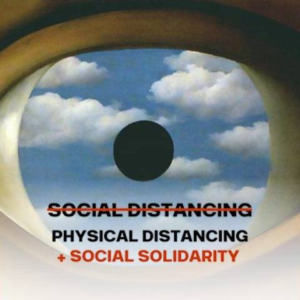Community responses to COVID-19: early research findings
In April 2020, Local Trust commissioned the Third Sector Research Centre (TSRC) to explore how 25 communities in England respond to COVID-19 and how they recover. This blog shares early findings from the research and was written by Angus McCabe, Mandy Wilson and Rob Macmillan.
The newspaper headlines, to say the least, are not great. The death toll continues to rise and following recent events in other countries, there are increasing fears of a second ‘spike’ in the number of COVID-19 cases. The economy declined significantly in the first months of lockdown, crippling ‘even the most resilient of markets’ (Oxford University). There has been an unprecedented rise in unemployment (Resolution Foundation) despite the Government’s furlough payments. And COVID-19 has highlighted the inequalities that existed in the UK before the pandemic (Public Health England).
So not a lot to be ‘up-beat’ about and, as one community member suggested, keeping up the ‘propaganda of positivity’ can be a bit exhausting.
In terms of research, these are still very early days. Things are still changing and there are uncertainties for the immediate – never mind long term – future. These reflections on the early evidence gathered by the Third Sector Research Centre (TSRC) for Local Trust’s research into community responses to the pandemic are emerging. Yet, even now, if we look beyond the headlines about the economy and the health impacts of COVID-19, something else seems to be happening.
For a start, the whole rhetoric about ‘community’ has shifted. It’s not that long ago that some communities were being described as ‘divided’ or ‘broken’. ‘Community’, the posters now say, ‘is kindness’ (Jackarts.co.uk). Research by the Office for National Statistics as early as April this year paints a picture of unprecedented levels of informal, often neighbour to neighbour, mutual aid. But as the Power to Change report, Local Heroes, makes clear, mutual aid at scale needs community organisations, and organisations have moved quickly to respond appropriately. This report also makes the case that while community spirit is everywhere, some areas need more support, reflecting the findings of the report from Community Organisers, Locally Rooted, which explores the place of community organising in times of crisis.
What many communities have managed to do is build on that informality. The study’s first two research briefings for Local Trust anchor what is happening now in the context of responses to previous crises (e.g. the 2015-16 floods in York) and highlight the resourcefulness of many communities. Many dived straight into action, providing an immediate response to basic needs in the community – delivering food, supporting foodbanks etc. They have been critical in getting information out to communities. They have co-ordinated activity. They have identified gaps in emergency provision (families with very young children, for example) and attempted to address the gaps not recognised by others. They have used local knowledge to ensure that basic supplies reach the most vulnerable: meeting social needs, and combating isolation in lock-down: as one interviewee said “they know who needs that phone call, that knock on the door”. They have moved their regular activities to online drop-ins and in one area even organised a lockdown carnival.
The research study includes 20 Big Local areas, and 5 other communities. In the Big Local areas where residents have been supported to create community plans over a number of years, there is evidence that they have – by and large – held onto a longer-term vision for their communities. In difficult circumstances, they are planning for the future. At a time when Pro Bono Economics estimate that 10% of charities will close in the near future, long term funding has helped Big Local partnerships look ahead. While fearing the oncoming ‘tsunami’ (a term used by several interviewees) of unemployment, mental health needs and supporting vulnerable adults and children, they are thinking about how to re-open the community hub with social distancing in place and some are also reviewing their past community offer and considering how they might play a strategic role in the future of local economies and local services. But they are also thinking about legacy. What will Big Local leave behind in a few years’ time? For some that is an organisation. For some it’s a building. For others it’s about green energy and community investment. But most of all it’s about leaving behind, or carrying on, social networks and community infrastructure that have (to use the current jargon) ‘shielded’ communities in a crisis.
Maybe the key challenge is sustaining the belief that, despite everything, all post COVID-19 communities can be even better places to live; but the key hope, is that the social solidarity of the crisis is sustained.
Written by the TSRC research team as part of Local Trust’s research on how communities respond to and recover from COVID -19.
Find out more about this research


